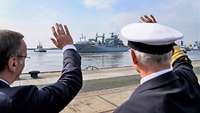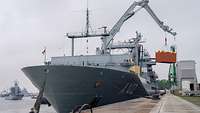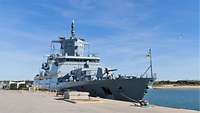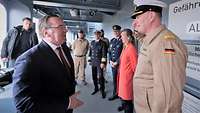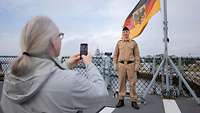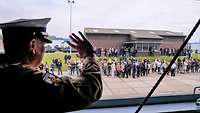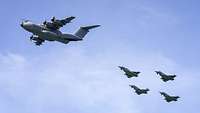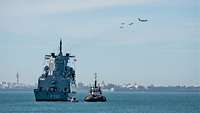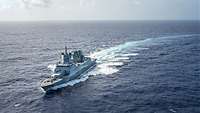German Navy begins Indo-Pacific Deployment 2024
German Navy begins Indo-Pacific Deployment 2024
- Date:
- Place:
- Wilhelmshaven
- Reading time:
- 4 MIN
On May 7th, frigate FGSFederal German Ship “Baden-Württemberg” and replenishment ship FGSFederal German Ship “Frankfurt am Main” left port for their major naval exercise. “Baden-Württemberg” set off from Rota in Spain, while “Frankfurt am Main” from Wilhelmshaven.
Defence Minister Boris Pistorius said goodbye to the Auxiliaries Squadron’s replenishment ship “Frankfurt am Main” and its crew in its home port in Northern Germany. Parliamentary State Secretary Siemtje Möller as well as the Chiefs of the German Navy and German Air Force, Vice Admiral Jan Christian Kaack and Lieutenant General Ingo Gerhartz, were also on site.
“The Indo-Pacific Deployment is a complex undertaking by our naval and air forces with a special focus on the Pacific – a region of increasingly global, strategic importance also for Germany and Europe,” said Pistorius. “We want to strengthen our regional partnerships and consolidate our position as a reliable actor in the region.”
The frigate already has a head start
Meanwhile, frigate “Baden-Württemberg” set sail from Rota naval base on the Spanish Atlantic coast with her crew of the 4th Frigate Squadron. The ship had already set off from the Wilhelmshaven naval base in October last year for the naval component of the UNIFILUnited Nations Interim Force in Lebanon mission in the eastern Mediterranean Sea.
After frigate “Brandenburg” replaced her in the Blue Helmet mission at the beginning of April, “Baden-Württemberg” sailed from the eastern Mediterranean to the Spanish NATONorth Atlantic Treaty Organization base near Cádiz. Here the crew prepared for the seven-month major project of the Indo-Pacific Deployment (IPDIndo-Pacific Deployment). The Type 125 frigate is the flagship of the naval task group.
“Baden-Württemberg” is embarking on this world tour with around 180 sailors on board, which is formally defined as a training cruise, but will also have operational components. On board “Frankfurt am Main” there are around 200 sailors. Additional personnel reinforce the crews on both vessels: on the frigate, naval aviators from Naval Aviation Squadron 5 for the on-board helicopters and naval infantry of the Sea Battalion, and on the combat support ship, primarily naval officer trainees.

“Not standing up for the rules-based international order is not an option for Germany.”
“In the Indo-Pacific region, what is particularly important is freedom of navigation, freedom of shipping, freedom of trade routes,” said Minister Pistorius, explaining the overarching background of the IPDIndo-Pacific Deployment. International law was an essential cornerstone of the rules-based international order, which was repeatedly being put under pressure or questioned. “We want to contribute to compliance with international law and expand our relationships with our partners there in the region,” said Pistorius about the defence diplomacy mission. “Looking the other way, not showing a presence in the Pacific and not standing up for the rules-based order is and will not be an option for Germany.”
During Germany’s IPDIndo-Pacific Deployment 2024, partner nations from the Indo-Pacific region will also send naval units to Europe. “When the German task group hails at Tokyo, a Japanese naval training force will be in Hamburg almost at the same time,” announced Chief of Navy Kaack on the occasion of the departure of the German ships. “We agree with the Japanese Maritime Self-Defense Force: What happens politically in the Indo-Pacific can also happen to us in our areas,” said the vice admiral.
Germany’s partners from the Indo-Pacific also show a maritime presence
The two ships will meet in the eastern Atlantic in three days and then continue sailing together. The first exercises with the Royal Canadian Navy and the United States Navy are already planned off the east coast of Canada and the USA. The IPDIndo-Pacific Deployment task group will first call at Halifax and later New York. The ships are expected to pass through the Panama Canal at the beginning of June.
From June to November, “Baden-Württemberg” and “Frankfurt am Main” will continue to sail in a generally westerly direction in the maritime areas of the Pacific and Indian Oceans between the USUnited States west coast and the coasts of India. Almost at the same time, from June to August, the German Air Force, together with the air forces of France and Spain, will also move around the world and show the flag together in the region. A total of around 50 aircraft will be on the move, including over 30 from Germany.
The fighter and support aircraft will take part in a total of five international exercises: in Japan, Australia, India and twice in the USA. The major USUnited States exercise RIMPACRim of the Pacific in the central Pacific has a special meaning because the German Air Force and the German Navy are training here together with partners. This makes this year’s Indo-Pacific Deployment the most complex that the Bundeswehr has ever carried out.


